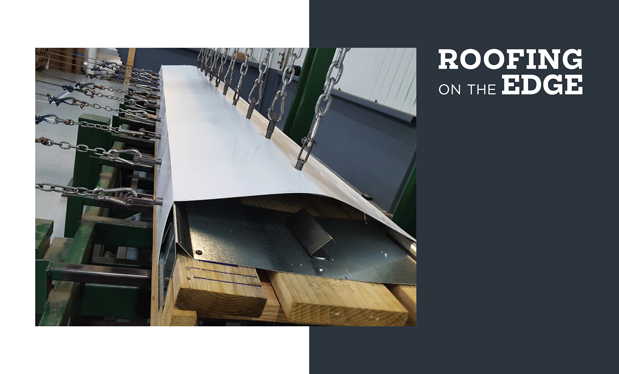Built-up roof systems, known for their durability and reliability, have been used in roofing applications for more than a century and remain a viable roofing solution. These types of roof systems have withstood harsh weather and the test of time—demonstrated by decades-old built-up roof systems still in service.
Using modern and innovative practices such as "low-odor" and "no-smell" solutions and modified asphalts, built-up roof systems have continued to adapt to serve the commercial building market.
Sustainability
According to "Sustainability Favors the Long Life Cycle of Asphalt Roofing," published by the Asphalt Roofing Manufacturers Association (ARMA), it is possible to extend the life cycle of a built-up roof system by using coatings. According to the article:
"The technology for extending asphalt BUR and MB roof life cycles has been under development for decades. Much of the old technology is still valid but now much more field experience exists. Many studies have demonstrated that the life of these roofing systems can be significantly extended through the use of appropriate coatings. ... The technology of coatings today could potentially extend the life cycles of roofing systems indefinitely."
Built-up roofing can provide a durable base for extending a roof's life cycle through the use of coatings. The potential lifespan of an underlying roof system should be an important part of any sustainability conversation.
Built-up roofing also is an ideal option for vegetative roof systems and inverted roof membrane assemblies. A crucial element of an effective vegetative system is incorporating a roof system that can withstand extensive foot traffic from gardeners and others maintaining vegetation, which can cause roof membrane punctures. If a membrane leaks, repairs can be costly because not only will the roof membrane need to be repaired, but the repairs also could include the removal and replacement of irrigation and vegetation. In such cases, built-up roof systems have a clear advantage. With unique seam redundancy and thickness, built-up roof systems can handle the increased impact of planting and gardening.
Energy-efficient
There is a lot of industry buzz around the benefits of reflective, light-colored (or white) roof systems. Dark-colored roof systems also can be an energy-efficient solution in some situations. With innovations such as coatings and reflective cap sheets, built-up roof systems can be light- or dark-colored.
ARMA's article, "Sustainability Favors the Long Life Cycle of Asphalt Roofing," states:
"Not long ago, the idea of 'green' came into direct conflict with the ideal of a long life roof. Oddly enough, the longest life roof available was an asphalt BUR, which tended to have low values of reflectivity and emissivity. As the charge toward green was being led by the cool roof movement, this excellent long life cycle roofing system nearly became a casualty of friendly fire. Fortunately, manufacturers soon realized that the white surface is only skin deep, and it is a small matter to produce a white cap sheet or provide a white coating on a modified bitumen membrane in the field."
However, it is important to note dark-colored roof systems can be an energy-efficient solution in some situations. For example, dark-colored roof systems are shown to conserve energy better than light-colored options in some cold-weather regions.
According to the article "More Than a Simple Black and White Issue" published by Versico Roofing Systems, Carlisle, Pa., an average of three to five times more energy is spent on heating over cooling needs in colder climates.
In these areas where the climate experiences longer periods of cold weather, a dark-colored roof system could be more effective for keeping a building warm and conserving the energy to do so.
In addition, the accumulation of dirt and dust on the surface of a highly reflective roof system will cause loss of reflectivity over time, significantly decreasing its effectiveness. The results of a 2004 study "Long Term Reflective Performance of Roof Membranes" published by the Cool Roof Rating Council® showed all membranes lose reflectance over time in all climate zones, and the loss of initial reflectance after three years in the field is 20 to 50 percent. Washing the membranes was the only way to restore reflectivity.
The article "Economic Feasibility of Cleaning Roofs to Maintain Their 'Solar Reflectance' Ratings" published by the Cool Roof Rating Council provides insight into the financial break-even points when comparing energy-cost savings with the costs of regular cleaning. According to the article, if a building owner chooses a light-colored roof system for the energy benefits in an appropriate climate, he or she should be prepared to have the roof cleaned as part of regular maintenance.
Another important consideration when selecting a highly reflective roof is algae and condensation. According to the energy.gov website:
"In warm, moist locations, cool roof surfaces can be more susceptible to algae or mold growth than hot roofs. Some roof coatings include special chemicals that prevent mold or algae growth for a few years. In cold climates, roofs can accumulate moisture through condensation, and it is possible that cool roofs might be more susceptible to accumulating moisture than dark roofs of the same design. Condensation can be avoided using proper design techniques."
However, if it is determined a highly reflective roof system is the best option for a building's needs, a built-up roof system can be adapted to meet cool roof requirements by using light-colored built-up roofing options.
Durability
There are many reasons why a roof system fails, such as poor design, lack of real-world testing, water intrusion and/or poor fieldwork. Although warranties can be a significant factor when deciding to purchase a particular roof system type, they do not guarantee a roof will protect assets inside a building. According to "When It Leaks, It Pours," published in The Journal of The American Institute of Architects in 2011, water intrusion makes up more than 70 percent of construction litigation.
Facilities that hold highly valuable assets and operate "around the clock" benefit from built-up roof systems because of their proven durability and longevity. Government buildings, data centers and schools have benefited from the reliability of built-up roof systems. The "Unified Facilities Criteria for Roofing" document that governs all U.S. federal buildings built under the direction of the Department of Defense identifies asphalt built-up roofing as a preferred roof membrane option. It recognizes the long service life, low maintenance and durability of an asphalt built-up roof system and lists it as having "broad-applicability" for dependable low-slope roof systems.
This durability was further proved in 2011 when a major storm hit Dallas. Tornadoes and hail caused millions of dollars of damage. The Roofing Industry Committee on Weather Issues Inc. conducted a hailstorm study and looked specifically at the damage to various types of roof systems.
In some areas, the roof systems were struck with hail measuring 1 3/4 inches to 5 inches in diameter. A vast majority of built-up roof systems in the study suffered minor damage compared with other roof system types. On a scale of 0 to 5, the built-up roof systems in the report ranged 1 to 2 on the damage scale—1 indicating minor surface impact marks and 2 being minimal damage. Most of the damage recorded on the built-up roof systems was gravel displacement and scuffing.
With built-up roof systems currently in service that are more than 50 years old, the potential life cycle savings from a high-quality, four-ply, gravel-surfaced or SBS polymer-modified bitumen membrane with regular maintenance is significant.
Built-up roofing holds up well in extreme weather, and decades-old built-up roof systems still in service prove this fact. However, a top concern of using asphalt in built-up roof system installations is safety and health, which begs the question: Are asphalt fumes safe?
Asphalt safety
Some people don't like the smell of asphalt, and this has led to a misconception that asphalt fumes are inherently dangerous and cause cancer. In a 2016 quantitative risk assessment of asphalt roofing fumes sponsored by NRCA, the Asphalt Institute® and ARMA, the study concluded: "The weight of epidemiology evidence [i.e., human studies] does not support roofing asphalt as a risk factor for lung cancer because, among other things, the increased cancer rates found in some of these studies may be attributable to coal tar, asbestos, smoking, or another factor."
Based on the study, the cancer risk of breathing average outdoor air in the U.S. is about 2,500 times greater than a roofing worker's asphalt-related lung cancer risk. It also revealed the risk of developing lung cancer is eight in one million during a 45-year career working in an asphalt plant. Based on the study, it is clear there is minimal to no evidence linking asphalt fumes to a significant risk of cancer.
Not only does this point to minimal risk from fumes, but innovative, new approaches to installing asphalt also are reducing odors and fumes. Some companies use low-odor or no-smell asphalts that reduce or virtually eliminate the asphalt smell. When combined with asphalt that has a high flash point, fumes and odors can be reduced dramatically on a job site.
Many complaints can be avoided by careful job-site planning and staging. Often, asphalt manufacturers will provide job-site consultation to help contractors stage the job in a way that ensures minimal disturbance of building occupants or neighbors during installation.
Environmentally sound
Commercial building owners can be confident an asphalt built-up roof system also is safe for the environment. Asphalt is the most commonly used material in road construction and residential roofing. One aspect of the environmentally sound nature of asphalt built-up roofing is further shown by a study conducted by the Washington State Department of Ecology that examined rainwater runoff for a variety of roof system types. The "Roofing Materials Assessment—Investigation of Toxic Chemicals in Roof Runoff from Constructed Panels in 2013 & 2014" was conducted to determine whether roofing materials contribute to the release of toxic chemicals. The study found built-up roofing did not release significant levels of metals or toxic compounds when compared with other types of roofing materials.
Incidentally, the International Living Future Institute© offers "The Red List" of toxic materials found in the building industry, which includes PVC. Asphalt built-up roofing contains no items listed on "The Red List."
Challenges
No roof system is perfect for every application. A major challenge built-up roofing contractors face is the same challenge plaguing the entire construction industry—finding enough skilled workers. The reality is it takes skilled, well-trained workers to install a high-quality built-up roof system.
As the labor market continues to tighten, experienced roofing workers continue to be in high demand. Bidding jobs with experienced built-up roofing contractors can help mitigate concerns about labor and the initial installed cost of a built-up roof system. Surprisingly, the installed cost of a built-up roof system can be competitive with other comparable systems, especially roof systems with a large number of penetrations.
A smart choice
From sustainability to stormwater management, every commercial building has a set of requirements, environmental factors and limitations that must be taken into consideration before selecting a roofing solution. Asphalt built-up roof systems have demonstrated outstanding longevity and adaptability, making them a smart choice for a wide variety of commercial roofing applications.
Jason Lange is business and product development manager for United Asphalts, Denver.



